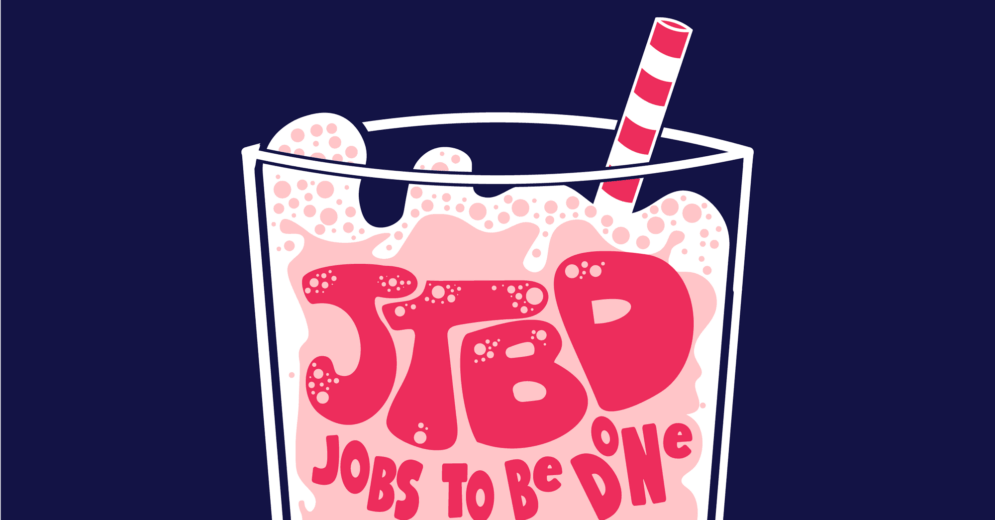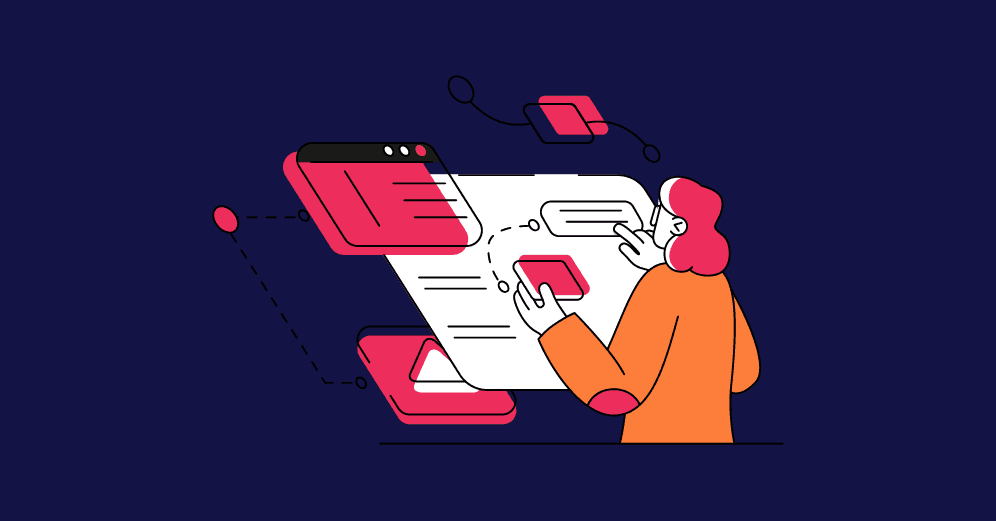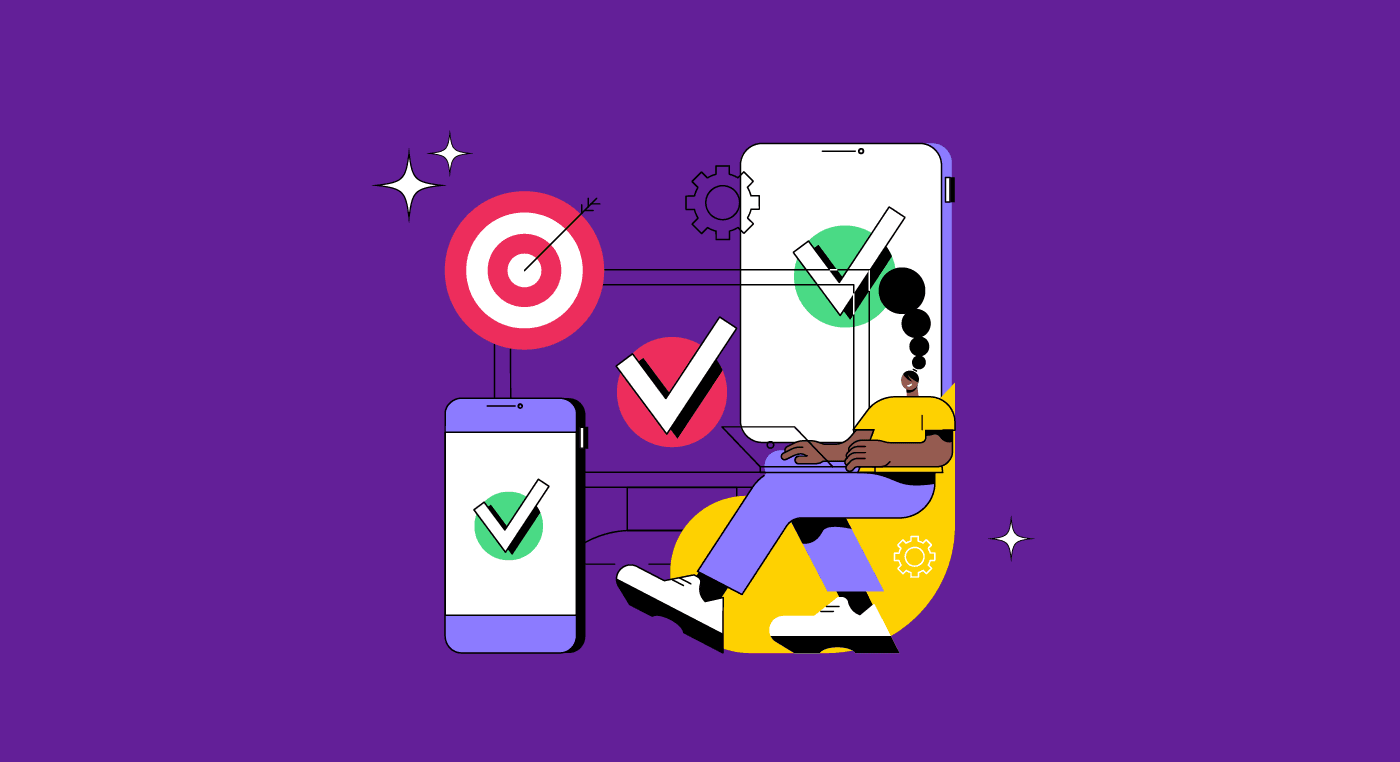The main goal of UX Design is discovering user needs and solving their problems. The Jobs To Be Done theory gives an interesting perspective on user needs because it looks beyond the tasks users need to complete and looks at how likely people would adopt an innovation.
Keep reading to know more about JTBD and minimize the risks of launching a product that customers won’t buy!
About Jobs To Be Done
Jobs To Be Done is a theory to understand the process behind why and how people buy products or adopt innovations to upgrade their current life situation. This improvement is their goal, their job to be done.
For example, when users buy a music streaming service, it can be to actually listen to music (task) or relax during their work commute (JTBD).
The job to be done goes beyond just listening to music; in this particular case, it can be about being a happier person, someone who arrives at work in a good mood.
And to accomplish this purpose, users will go through many options that could help get their job done: a Pendrive loaded with music, CDs, audiobooks, meditation, etc.
The process customers go through while looking for other alternatives on the market is called hiring. Customers hire products to get their jobs done.
Therefore, JTBD provides a different perspective for developing new solutions, treating the product as a means to perform a job, or overcoming obstacles.
In the video below, Clayton Christensen explains a famous example of JTBD and milkshakes:
So, what's the difference between a Job and a Task?
In this context, Tony Ulwick, founder of Strategyn, talk about the different kinds of job:
"Emotional jobs define how customers want to feel or avoid feeling as a result of executing the core functional job. Social jobs define how the customer wants to be perceived by others."
When we refer to a job within the theory JTBD, we refer to which products people "hire" to fulfill their desires.
Imagine yourself walking downtown during lunchtime. Suddenly, you realize you're starving and craving to eat something.
In this situation, the task you need to complete is getting lunch, and to solve this need you can "hire" a sandwich, a salad, or even pasta in an Italian restaurant.
But the job goes a bit deeper; if you're on a specific diet, you will look for healthy places to eat. These places will probably reflect the lifestyle of the person you want to become.
Do you see how a Job digs a bit deeper than a task? This new perspective and understanding of needs are the main focus of JTBD theory.
What you need to do x Who you want to become
Things we need or want to do are different from how we want to feel and who we want to become.
You might want to spend more time with your child to be a better parent. And to do that there are many activities you can choose from: having a picnic, going to the movies, cooking together, playing lego, etc.
The success of your task, of your job, won't be about the activity itself, but whether your kid had a good time or not and consequently, made you feel a better parent.
Jobs to be done for business growth

If we analyze, JTBD helps different levels of business, from executives to users.
This way, using the Jobs To Be Done theory helps companies:
- Implement a culture focused on user needs;
- Identify gaps in user experience;
- Measure how efficient your products and digital interfaces are;
- Understand how to add value to products;
- Keep an innovation mindset to avoid being swallowed up by competitors;
- Understand which jobs your products help solve;
- Identify opportunities for improvement in their products;
- Create more assertive communications focused on the jobs and needs of users.
JTBD framework for Product Development and Innovation
As seen, a job is a desire waiting to be fulfilled. These desires to accomplish something might be about improving processes or improving ourselves.
This way, people usually turn to products or services to achieve the desired state.
And that is why JTBD should be closely related to product development and innovation processes. It's much easier to sell a product when you know the jobs that can be done with it.
Jobs To Be Done on point: things to avoid
Be careful with a few common missteps when using JTBD, like:
- Defining the job too abstractly
It's easy to get lost when determining what precisely a user's job is. And it's not uncommon to find teams defining a job as: "people want to become good cooks."
But the problem with this formulation is that it is too abstract. What does it mean to be a good cook? Can they achieve this goal by using your product? Moreover, maybe their actual job is to impress their loved ones.
Therefore, it is crucial to research, analyze and define the jobs with more criteria in order to guide the development of new products.
- Labeling jobs
Emotional, function, or social Jobs? Every user job is unique, and it's more practical to think of it that way. Don't waste precious time trying to label it. Jobs are a combination of emotional desires like self-expression, belonging, and control, so there's no point measuring it objectively.
If someone buys a new shirt to impress their mother-in-law, does it make it a "personal" job because it references insecurity, or is it an "emotional" job because they want to impress others?
What matters is: they want their mother-in-law to like them; they want to feel approved. And that's how we can measure the success of this job example.
Remember: Never measure how successful a job was by task completion — which in this case would be buying a new shirt. If the task was completed (the person bought the shirt) but the mother-in-law didn't like them, the job didn't have a successful outcome.
Jobs To Be Done Principles
To better define and work with JTBD, Strategyn has listed nine principles of Jobs To Be Done:
- Users have a job they want "done"; they buy products and services to complete these jobs;
- Jobs are functional, with emotional and social characteristics;
- JTBD is stable over time;
- JTBD is solution-independent;
- The job is the unit of success analysis, not the product or the task;
- Understanding users' jobs make marketing more efficient and innovations more predictable;
- Customers want to complete their jobs in the best and cheapest way;
- People are often looking for products or platforms that allow them to complete the job thoroughly, rather than relying on one product for each part of the job separately;
- Opportunity for innovations presents when customers use products in ways they weren't initially created for.
Keeping these principles in mind, it becomes clearer how we can work with JTBD and get the most out of this theory.
- On a side note: Strategyn is an innovation consultancy founded by Tony Ulwick, whose theory about ODI contributed to the definition of what would become the Jobs To Be Done theory, popularized by Clayton Christensen.
Jobs To Be Done: theory and framework

Jobs To Be Done ends up being both a theory and a framework.
The theory
A theory is a set of rules and ideas that reflect a view over a specific phenomenon. Accordingly, JTBD is a theory because it does just that: it makes us observe users' needs and reflect upon their inner desires.
This way, Jobs to be Done is a theory around consumer action. It describes what truly drives customers to buy products and how we can measure the success of a product or "job done."
Before users complete a job, they have a couple of desired outcomes in mind that define the successful execution of that job. If we capture these metrics (expectations), we can turn them into statements to help create new products.
Also, these expectations can describe how users measure value. Therefore, they are the perfect sort of information companies should know in a process aimed at creating products and services with more value-added.
The framework
Frameworks are quite common in development and UX, a template that guides us to apply a certain process.
Therefore, when we say that Jobs To Be Done is a framework, it means that there's a template to follow so we can put the theory into practice.
Strategyn created a JTBD method to implement better solutions for their customers, improving their product development processes. Take a look at the framework in the next section.
How to use JTBD to develop new products

Ulwick's consulting firm Strategyn developed a strategy to put in practice the JTBD theory. Outcome-Driven Innovation (ODI) is a method that helps companies create and market innovative products.
The process happens in six steps:
- Define the market and the Job To Be Done;
- Discover user needs;
- Measure how successful the needs are being met;
- Discover opportunities;
- Alignment of existing products and market opportunities;
- Develop new products to fulfill unmet necessities.
1) Define the market and the Job To Be Done
According to Ulwick, once we can identify a group of people with the same Job To Be Done, we can also define the market.
This way, asking specific questions is essential to identify which job a particular group wishes to accomplish.
Notice that most of the products out there help customers in only one part of the job. So if you ask someone, "for which job did you hire this bicycle?" the answer will probably be something like "to get to places."
However, people buy bicycles for hundreds of reasons. So the ultimate goal could be: to be healthier, to lose weight, to be more energetic, and outdoorsy, or to impress someone.
Remember that people will hire several products to progress into their desired state. For example, if the job is to lose weight, they will eat healthier, buy a gym membership, a bicycle, etc.
Therefore, to find out what customers are genuinely trying to accomplish and what their job is, change the direction of the question a little:
- When you are using this product, what is your ultimate goal?
- Is the product helping you fulfill which inner desire?
From this approach, you can extract and identify what job the user is trying to get done.

2) Discover user needs
Once we start investigating, we can see that every Job has a series of needs tied to it. Users are usually aware of their needs; they know what they want. The point of confusion is mistaking needs for solutions.
Let's analyze the classic example of Henry Ford: people didn't ask him to create a car, but they did know they had to get from one place to another faster. That was their need, and the car was the solution.
Of course, the need is not always so clear. Sometimes, to reveal a particular need, we must look at all the existing problems of current solutions.
To help uncover these needs, Ulwick created a template called the Desire Outcome Statement that has the following structure:
- Direction of improvement + Performance metric + Object of control + Contextual clarifier
Example:

3) Measure how successful the needs are being met
Uncovering user needs makes sure the process is customer-centric and the quantitative research methods provide you with insightful data, essential to minimize innovation risks.
The research was designed by Strategyn to achieve the following goals:
- How can you get the job done better? When researching your target users, look for complaints about their current solutions.
- Are there any gaps that can be improved?
- Can you get the job done cheaper? Some needs may be overserved, so you might be able to focus on other aspects to provide a more affordable alternative.
- How successful are your customer's needs being served? With the importance and satisfaction data obtained for each outcome embedded in the JTBD, you can define their priority order and focus on what matters most.
- What are your competitors' weaknesses and strengths? Remember that competitors can be any product your target customers hire to meet their needs.
4) Discover opportunities
One of the advantages of using the Jobs To Be Done framework is its ability to reveal hidden opportunities that would hardly be noticed through other methods.
A crucial lesson to remember is that the same job involves different complexities depending on the context and the person trying to perform it.
Knowing what those complexities are and which outcomes may be underserved is the key to formulating an effective market and product strategy.
Tony takes an example of saws to explain: according to their research, 30% of tradespeople who used circular saws to cut wood in a straight line had 14 unmet outcomes, while other users didn’t have any.
This hidden segment (users with unmet needs) struggled more to get the job done because they had to make more finish cuts and cut through long pieces of wood.
So with this information, the company from this case study then created a particular circular saw to serve these users.
5) Alignment of existing products and market opportunities
After identifying the market, the Job, and the needs, the next step is to understand how the company's existing products align with newfound opportunities.
Usually, there is no need to implement additional features in the product; a simple shift in communication strategy can already deliver good results.
The essential part is understanding how products meet users' needs and help them achieve their goals.
6) Develop new products to fulfill unmet necessities
The last step of the Jobs To Be Done framework is developing new products to address hidden and unmet needs.
By following the framework step by step, it's possible to unravel needs that no other competitor or product has foreseen. And this is where unique opportunities for innovation and success lie.
Therefore, analyze the needs that are not yet being met and think about how you could develop products to meet these goals.
Reading tip: Building Prototypes: What’s The Best Type For Your UX/UI Project
Final considerations
The theory and framework of Jobs To Be Done can do wonders for innovation and new product development processes.
However, they are just part of a more extensive product development process.
Remember that other methods like Research, Design Thinking, Double Diamond, and many others, complement JBTD and are extremely important for UX Design.








